Project Nomads

| a game by | Radon Labs GmbH |
| Platform: | PC (2002) |
| Editor Rating: | 8/10, based on 1 review, 3 reviews are shown |
| User Rating: | 6.2/10 - 83 votes |
| Rate this game: | |
| See also: | Third-Person Shooter Games |
The rts genre is in a wee bit of a rut as far as originality is concerned. Take your pick from any number of fantasy and sci-fi clones, from the reams of ancient history based doppelgangers, and more recently from the glut of WW2 themed battlers. Where's the inspiration for the next far-sighted, trailblazing envelope-pusher going to come from, then? The most unlikely of sources, as far as Radon Labs, developers of intriguing looking 3D action/RTS Project Nomads is concerned: the works of a largely forgotten author, an area in central Europe, and some weird dreams.
"The inspiration comes from the most eastern part of Germany, which is where Radon Labs is based," says Friis Tapped, a producer on the game. "The books of Jules Verne were also an obvious influence, along with the common dream of flying." Hmm. What about that dream where all your teeth fall out and the one where the 'woman’ you were just 'loving’ turns into a man? To deny these is to deny oneself.
Returning, if you’ve not caught any of our coverage up to now, here's an overview. Project Nomads is set in a world where an apocalyptic war with an insectoid alien race known as the Skrits has broken the land into a myriad of islands, which now float forlornly through the clouds.
The survivors of this cataclysm are few, led by the Nomads, wandering sorcerers gifted with the power of flight. As a Nomad, it is your task to rally against the alien invaders who have taken advantage of the situation to try and conquer what's left of your people.
Arcane Technologies
As mentioned, this world is a Jules Verne/H G Wells style piece of Victorian gothic imagination. Automated factories that spew fire out of towering smoke stacks. Turbine generators that supply power. Steam-driven gun turrets that fight off enemy attacks by lumbering Zeppelins and whirring biplanes.
The standard vehicle in this airborne world, unsurprisingly, is the aircraft. Big or small, as long as they look like something that was drawn up around the turn of the last century, they’re here.
So no ground combat at all? "No, no grunts or tanks - players have access to a huge variety of planes, gun turrets and such but no ground units. But the enemy - the Skrits - do have ground units, so players will encounter them," continues Friis.
Hands Off
Radon Labs are keen to keep micromanagement to a minimum, allowing the player to concentrate more on the two fundamental elements of strategy and action. "There is only one resource to collect: energy. And one technology; artefacts. Juggling the artefacts, managing the energy and replacing and repairing things are the only real micromanagement facets of the game," says Friis. "Each vehicle and building has a certain artefact. The player has to find them, trade them in the market place or earn them through completing missions." This emphasis away from swamping the player with onerous tasks also stretches to the unit balance.
Friis adds: "Each hanger can only house a single aircraft, which keeps unit numbers low. Since the player does not manage units but operates from his central base - or his islands -everything is normally in his sight. The player can switch through all controllable objects by simply pressing a button.
This is not a mass-unit game meaning the player is always in control.
Propeller Heads
And though the game plays out as a traditional RTS, and it’s possible to win battles without getting your hands dirty, the onus is on getting directly involved with the fighting to tip the balance.
"It will be very, very hard to win battles without getting personally involved in some way. Certain vehicles and buildings such as the basic guntower will not function at all if not manned by the player. But most, including all the aircraft and more advanced guntowers are automated and will fire of their own accord. But objects controlled by the player have a little boost to them to ensure players do not get lazy. Upgrading all your stuff to make it auto-controlled costs you and will mean you have fewer units. It’s your call..." says Friis.
Interesting, says us. And what with a single-player campaign comprising four chapters, that encompass 31 missions, three playable characters, each with a unique set of units and buildings to construct, it looks like having its fair share of meat too. Expect a review in a few months.
Download Project Nomads

System requirements:
- PC compatible
- Operating systems: Windows 10/Windows 8/Windows 7/2000/Vista/WinXP
Game Reviews
There’s only one thing worse than being locked in a room with an EastEnders scriptwriter, and that’s being locked in a room with an action/adventure game scriptwriter. The horrible truth is that plots for most 3D action games are so excruciatingly banal you’d rather put leeches on your eyeballs than read the dross that appears at the beginning of most manuals.
For once though, we have good news. Project Nomads’ storyline is unique in so far as it appears not to have been hastily contrived on the back of a fag packet after the rest of the game was finished. So, without giving too much away, here’s the deal. The aim of Project Nomads is to exact revenge upon a group of beings known as the Sentinels, who destroyed the Nomads’ home world and left it as fragments floating around in space. Playing as a Nomad with a large floating lump of rock (or island if you prefer) as your 'ship’, you must 'sail’ your way around the remains of your old world to kill the Sentinels and their leader, and find other Nomads.
OK, so it may not sound like award-winning material - if anything it sounds a bit rubbish. But judging by the intricate structure of the game itself, it’s a fair bet the plot for Project Nomads existed long before the first line of code.
Rock Steady
Although first and foremost Project Nomads is a no-nonsense action game, there’s a wonderfully subtle RTS aspect to it. Basically, in order to reach the other floating fragments, you transform your island into a kind of flying fortress by constructing special buildings. You do this by picking up building icons (or artefacts) which can be found scattered across the floating landscapes, or by destroying enemy buildings.
The most important structure you can build is your watchtower, which is basically your island’s engine. Without this you won’t be able to sail anywhere. The second most valuable add-on is your lighthouse. This is the heart of your island and if that’s destroyed it’s game over - simple as that. On top of these essential structures you can have other placements such as gun turrets, aircraft hangars, power plants, collectors, and artefact storage units.
Island Breeze
One of the most outstanding features of Project Nomads (apart from its original game design) is its variety. At the start of the game you can choose from three different characters: Goliath, John and Susie. As you might expect, each character has distinct strengths and weaknesses. Goliath’s gun emplacements are the most powerful (if a little on the slow side). Susie on the other hand has a slightly weaker gun that fires much more rapidly. It goes without saying of course that the final character, John, is a jack-of-all-trades - he’s the guy to pick if you want a bit of everything.
Standard stuff of course. However, what is unique about this initial choice is that it also radically alters the look of your island. Susie, for example, has very elegant, fragile-looking buildings, whereas the sturdier Goliath has much tougher structures. Basically the personality of your character is stamped on the graphics, and ultimately the entire game.
The visual appeal of Project Nomads is staggering. The backgrounds are moody, the floating islands are suitably eerie and the textures of the buildings and aircraft are superb. There’s even a constant wind that rustles through the branches of the trees, as well as a full day/night cycle. If there is a criticism it’s that some of the miscellaneous monsters you see wandering around the islands are a bit bland. You get the distinct impression that when it comes to creating great-looking adversaries, Radon Labs focused its imagination on the Sentinels and nothing else. The sound is also great. The effects for the explosions are particularly booming, and in a stroke of pure brilliance the apocalyptic tone of the narrated cut-scenes sounds almost professional. Once again, a privilege not often associated with 3D action/adventures...
Happily Engaged
Project Nomads offers several different ways to engage the enemy and generally it’s up to you to decide which method is appropriate at the time. The first method of attack is the simple gun turret. This immobile, yet effective primary defence of your island is great for taking out incoming Sentinel aircraft. The next and highly risky attack option is by foot. However, these ground skirmishes are rare, as they only tend to happen when your island docks with another island. The other problem with attacking or indeed travelling by foot is the collision detection; for some reason you often get stuck on sloping landscapes. While this is not a major problem, it does lead to frustration. Ultimately, when it comes to serious fighting, it’s the plane that gets the most mileage. The weaving, spiralling, deathdefying manoeuvres of aerial combat form around two-thirds of the game. Not that you ever get bored though; the great thing about the plane is that you can switch in and out of it at will; and when you’re not manning it, it simply reverts to automatic pilot.
Floating Point
There are eight main quests in Project Nomads with numerous sub-quests thrown in for good measure. One such minidiversion sees you stealing a Sentinel aircraft and then pretending to be part of an enemy squadron by staying in tight formation as you fly through some canyons. There are of course the out-and-out blasting missions to settle into, but at the same time there are still tricky tactical decisions to make to keep you at least partially on your toes.
For example, during a raid on some Sentinel AA guns, your own floating base comes under attack from an enemy bomber. At this point you have to decide whether to continue your assault, or hit the Tab key to instantly flip back to a cannon on your own island and blow the infidel out of the sky. If you bear in mind that a single strafing run from an enemy bomber can take out your lighthouse, these kind of decisions are not to be taken lightly.
Which pretty much goes for the whole game too. Project Nomads is a thrilling experience that should not be underestimated. Fair enough, it has its quirky collision detection problems, and if you want to be extra critical you could say it could do with a few more missions just to edge up the longevity. However, if it’s longevity you’re after there’s always the LAN/lnternet multiplayer game.
Overall, Project Nomads is one hell of a polished game. If you’re looking for a playable, original action game with a hint of strategy you won’t get much better than this. Go find those Nomads now.
There's a particular method of flight we can only ever perfect in dreams. It's that way of leaping vertically up from the ground and embarking on a serene and unrestrained airborne ballet. After that the dream might get rather surreal in that you are pursued by kipper-wielding nuns or everything turns into avocados, but let's not get into the details of my subconscious.
It's just one of those things that us clumsy humans could never hope to achieve in reality, but Radon Labs's jaw-droppingly beautiful Project Nomads comes tantalizingly close.
It's easy to see why this remarkably distinctive sci-fi adventure/RTS won best PC game at ECTS, aside from there not being much in the way of competition. The setting is truly innovative, a world of giant floating islands, the only fragments of the world left after an intergalactic war with giant alien insects. In fact, it'll probably be the next Kevin Costner movie. Populated by the Earth's last survivors, the islands are powered by a mixture of supernatural magic and Jules Verne-style technology. You play a flying wizard engineer, using arcane powers and a collection of ancient artifacts that turn your flying island into a mean, green fighting machine, with the eventual aim of taking over other islands in the batde for solid ground.
The islands can be reinforced with factories, power plants and various defence systems, as well as being customised with flowers, trees, maybe even shrubbery... with a path (a path!). Basically it becomes your own floating, killing Garden of Eden. A real-time day/night cycle, along with changing weather conditions such as wind and lightning, add to the all-round beauty of the game, which looks set to rival Black & White in the 'wow' department. You could say it's the game Sacrifice should have been. The skies around the islands are your battleground, and in the distance rival islands drift like sunbathing whales through the billowing clouds, surrounded by buzzing zeppelins and biplanes. Once you gain sufficient technology you too can gain control of such bizarre flying machines, taking rest from flying under your steam to do some real damage.
The developers are promising to create a seamless, organic environment, with no loading time between areas, thereby creating a hugely accessible world. The multiplayer aspect also looks intriguing, and features the ability to take your single-player islands online, enabling you to embark on some inter-island warfare.
Jules Verne had it right when he said, "Anything one man can imagine, other men can make real," and with Project Nomads Radon Labs is defiantly trying to make the stuff of dreams and wild imaginations a reality. Apart from the nuns and avocados, of course.




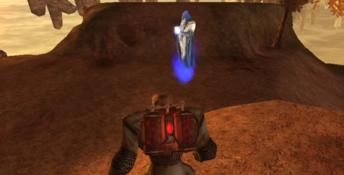





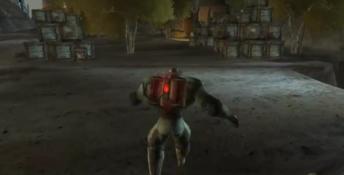






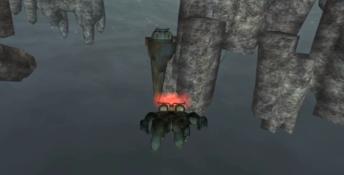

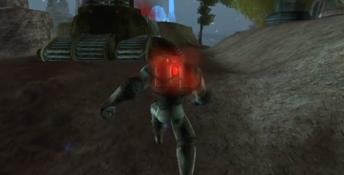



 Alien Nations
Alien Nations Conflict Zone
Conflict Zone Evolva
Evolva
 Fur Fighters
Fur Fighters MDK 2
MDK 2
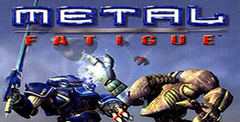 Metal Fatigue
Metal Fatigue
 Stranglehold
Stranglehold